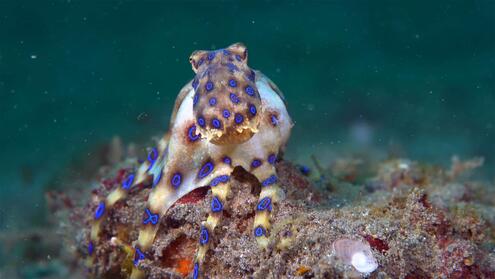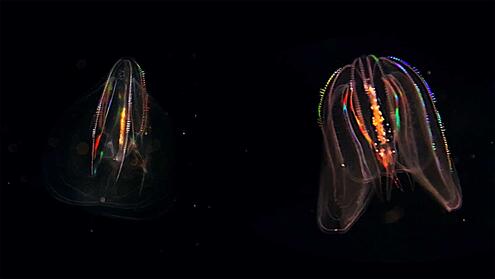COLOR
IN NATURE

A seahorse with orange spots. A comb jelly flashing rainbow-colored lights. A yellow and blue striped angelfish. A purple sea slug. Why is our world full of such colorful creatures? Scientists investigate the many ways that having colors, and being able to see them, have evolved to help animals survive and reproduce.
Here are some ways that animals use color.
To attract. Sometimes it’s better to be seen than to be hidden. Many animals use eye-catching colors to attract mates. Some use colors to attract prey.
To communicate. Some animals’ colorful exteriors let other animals know that they’re poisonous. But sometimes they’re pretending — their bright colors fool predators into thinking they’re poisonous, even if they’re not.
To hide. Animals use camouflage to hide by blending in with the background or resembling something they’re not, to keep them from getting eaten.
This video shows a fantastic variety of ocean animals that use color in various ways. Watch the video and then test your knowledge with a short quiz.
Color in Nature Quiz

Does the leafy seadragon use color for attraction, communication, or camouflage?
Attraction
Communication
Camouflage

The Museum gratefully acknowledges the Richard and Karen LeFrak Exhibition and Education Fund.
Generous support for The Nature of Color has been provided by the Eileen P. Bernard Exhibition Fund.
The Nature of Color is generously supported by Chase Private Client.
This educational resource for The Nature of Color is made possible by the Anna-Maria and Stephen Kellen Foundation.
Image Credits:
background pattern, © istockphoto.com, by Kroljaaa; all marine animals, courtesy of AMNH.




 Biodiversity
Biodiversity
 Brain
Brain
 Genetics
Genetics
 Marine BiOLogy
Marine BiOLogy
 MicrobiOLogy
MicrobiOLogy
 PaleontOLogy
PaleontOLogy
 ZoOLogy
ZoOLogy
 AnthropOLogy
AnthropOLogy
 ArchaeOLogy
ArchaeOLogy
 Astronomy
Astronomy
 Climate Change
Climate Change
 Earth
Earth
 Physics
Physics
 Water
Water





